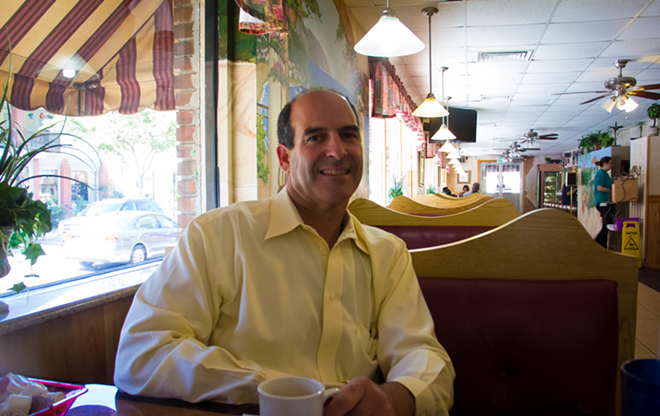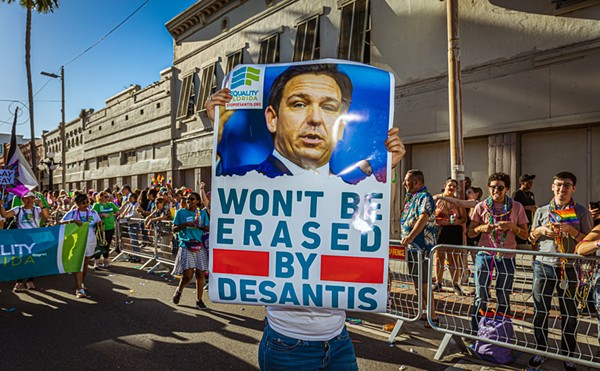As you walk along Main Street, past the diners and antique shops, it’s easy to get lulled into the sense that the politics here are about as complex and divisive as Mayberry's. But you’d be wrong. In recent years, elections have gotten more competitive — and nasty — and city commission meetings have been known to run well into the night.
The reason? Safety Harbor is home to two conflicting identities. Some want to keep it exactly as-is: small, artsy and lined with huge shade trees. Others see sprawling mixed-use developments in places where old apartment buildings and factories sit.
During a recent chat, CL told Safety Harbor Mayor Andy Steingold that in St. Petersburg, where the battle over the Pier rages on, some 16,000 people voted in a public survey on the designs, out of 250,000 residents. He was slightly taken aback; had Safety Harbor been asked to weigh in on such a major project on its waterfront, he reckoned, nearly every one of its 17,000 residents would have voted.
The city has its own list of unique political struggles, most pitting the desire to maintain its quaint charm against the lure of economic development.
Tree people
Just as candidates in most races, even the local ones these days, have to defend their positions on things like transit and health care, people seeking office in Safety Harbor have recently had to articulate something else: how they feel about the city’s iconic trees.
The tree issue came to a head last fall, when the Safety Harbor Resort and Spa cut down numerous large trees on an undeveloped area on its property to make way for additional parking. Few residents knew the resort was planning on doing so. When they passed by and saw the carnage — the naked stumps and tree limbs strewn everywhere — many were outraged, and protests were held outside the resort.
Steingold said the resort had actually worked with the city, and cut down fewer trees than initially planned. But the incident sparked a bigger conversation about the city’s towering shade trees.
The city placed a moratorium on cutting down trees while it looked at a way to protect more of them.
There had already been a “grand tree” ordinance on the books since 2007, but its criteria for determining whether a tree should be protected were pretty narrow. Trees had to be over two feet in diameter at a minimum and in near-perfect health. If someone cut down a large shade tree, they had to replace it, but could do so with a palm tree or some other tree that didn’t provide as much shade.
“We were losing 200 trees a year throughout the city,” Steingold said. “And they weren’t being replaced with shade trees. They were being replaced with palm trees, decorative trees, that type of thing. So the goal was to either protect the trees or improve the replacement process.”
In the run-up to the 2015 election, the debate over the ordinance pitted preservationists against people who opposed the measure out of concern for property rights. Steingold said the commission had to strike a balance between the two, even as opponents to the ordinance tried to paint Steingold and others as anti-progress.
“A lot of what took place in this last election was either misrepresentations [or] misunderstandings about the tree ordinance we were trying to craft,” he said. “A lot of people were saying we can’t pull a tree if we add a pool or are constructing a house on a lot. Well, that’s not what we’re trying to do. You can pull the tree, you can add the patio, you can add the pool, you can build on the lot. All we’re trying to say is, it’s a newly constructed home, and the lot is x-amount square feet, you’ve got to have one-plus trees depending on how big the lot is.”
The commission, a majority of them pro-tree, approved the ordinance ahead of the election. Now the commission, still mostly pro-tree ordinance, is talking about halving the fee for removing trees for residents, but not for developers.
To develop or not develop
Another divisive matter in the city is the issue of development. Whether it’s an individual seeking to build a towering McMansion that leaves little green space on his or her property or a developer seeking to put apartments and retail on a former industrial lot, such projects are often met with loud opposition from a faction that wants to keep the city small.
“I don’t know that they’re anti-development, but they want to preserve what you see around you right now,” Steingold said.
In 2012 and 2013, when developer Richman Group wanted to put up a sprawling apartment complex on what’s known as the Firmenich property at the northeast corner of McMullen-Booth Road and Route 590, residents of the adjacent neighborhood fought hard to shut it down. At the time, the commission leaned in favor of such projects, even as dozens of people lined up to passionately speak against it. Increased traffic was a concern; there were also questions about its environmental impact, and families worried about how an influx of renters would affect the safety of the surrounding area.
The commission passed the plan, but the County Commission voted it down, ostensibly out of concern for the county’s loss of industrial land and the jobs that go with it.
These who voted for it, including then-Mayor Joseph Ayoub, suffered politically for supporting the project. Steingold, who was on the commission from 2006 to 2013 before becoming mayor, but left his seat early to run, unsuccessfully, for a judgeship, said the commission’s handling of the issue was one reason he ran for mayor again in 2014.
He said he’s not anti-development (as some political opponents have made him out to be), and that Safety Harbor is inevitably going to change; he just wants it to be done right.
“It’s going to happen. The reality is, when developers have an opportunity to earn a living, and you can’t fault them for doing that, they are going to find a place like Safety Harbor,” he said. “They found South Tampa, they found St. Pete. They’re going to go to these areas and they’re going to develop new homes. That’s just part of our society in general ...By the same token, you have people that just want unfettered developable rights and they don’t want to necessarily fit in. They have a piece of property and they have what they want to do in mind, and they don’t really want to structure it in such a way that fits into the ambience of the city.”
As for the Firmenich land, Steingold said, it looks like another developer may have interest in it.
“I’m not necessarily at liberty to disclose who and what and that sort of thing, but I believe it’s got a large jobs component to it, and there may be a residential component,” he said. “When the time comes, I will personally reach out to the surrounding community just to get their temperature so that we don’t have the same issue, and so that the developer understand what’s going on and can partake as well.”
The Spa
It’s easy for outsiders to assume that the Safety Harbor Resort and Spa is the main economic driver in the town — that is, until one strolls around and sees the crowded restaurant patios and busy downtown shops. But the city has never done any kind of study to prove it.
The historic boutique hotel, with natural springs flowing into its massive ground level spa facility, does bring visitors to the area, many of whom dine at nearby restaurants, Steingold said, but he doesn’t believe the city’s brand or appeal rely wholly on the resort.
“They obviously feel that they are kind of the landmark for the downtown area,” he said. “To a certain extent they are, and to a certain extent, they aren’t. Our festivals thrive not because of the spa at the end of the street. They thrive because of the locale and the manner in which they’re put on, and they’re family events, typically.”
He said the spa and the city work together on many things — like the trees — but don’t always see eye to eye.
“It’s a give-and-take relationship,” he said. “We don’t want to take from them so that they don’t succeed, but there are rules and we’ve got to be able to operate the city within those rules ...It’s a balancing act to deal with them.”
A town without a Rep
You wouldn’t know it, but there’s an election underway in Safety Harbor right now. Early voting in the special election for the Florida House District 64 seat, started Monday. The election itself is April 21.
The vote for the seat was supposed to happen on November 2, 2014, like all of the other legislative races. But there was a legal challenge over the residency of a write-in candidate, which went beyond the general election.
But the special election is not something that’s really buzzing among the city’s residents. You probably won’t find any yard signs or see the two candidates, Republican incumbent James Grant and write-in challenger Daniel Matthews, glad-handing residents in Safety Harbor.
That’s because when state lawmakers redrew Florida’s legislative districts three years ago, they put Safety Harbor (as well as neighboring Oldsmar and East Lake) into HD 64, Grant’s District, which largely sits in Hillsborough County. Safety Harbor had previously been in HD 66 under then-Rep. Ed Hooper, a seat Rep. Chris Latvala now occupies.
Steingold doesn’t seem too thrilled about the new arrangement, and says he has yet to see Grant, or his opponent, reach out to the district’s Pinellas component.
“I’ve not seen him, nor has he contacted me to reach out to his constituents in Safety Harbor. Ever,” he sad. “In the time that I’ve served or in general.”















